Fri, 7 June 09:00
-
09:00 - 09:45 tanzhaus, Studio 3
Floor-Barre™
Warm-upThe Floor-Barre™ technique combines the principles of classical ballet with the anatomical basics of movement orientation and the economical use of the muscles. Movement orientation is improved, muscles are extended, the joints are strengthened, and the greatest possible turn out and stretch is achieved. Floor-Barre™ increases the body tension and serves rehabilitation and the prevention of injuries.
Joseph P. Cooksey (D) choreographer, dancer
-
09:00 - 09:45 tanzhaus, Studio 2
Gyrokinesis®
Warm-upGyrokinesis® trains the muscles and joints systematically and gently in rhythmic and flowing exercises. The different positions are softly and harmoniously connected by means of corresponding methods of breathing, making the exercises look like dance. Educated at the Martha Graham Dance School in New York the dancer and lecturer Laura Virgillito combines in her teaching different dance techniques with the Gyrokinesis® and Gyrotonic® System.
Laura Virgillito (D) dancer
Fri, 7 June 10:00
-
10:00 - 11:00 Capitol, Theatersaal
Dance as Image, Image as Dance
Jean-Luc Nancy’s considerations on images have always been related to their corporeal-sensual side: “power”, “intensity”, “intimacy”, but his focus is also on aspects of the “violence” of images.
“When I think, I dance,” says the philosopher Jean-Luc Nancy about himself. Hence, this dance-related, mobile and dynamic way of expressing thought manoeuvres in an in-between space in this lecture: When the philosopher raises the question of ‘Dance as Image, Image as Dance’, he also addresses transfers and translation processes that take effect between the “worlds” of the image and dance. Is the image really as motionless as it seems? Does the movement of dance have the potential of “(re)shaping”? Do the different forms of art – regarded as dance – have something in common?Jean-Luc Nancy (F) philosopher
Fri, 7 June 11:00
-
11:15 - 12:00 Capitol, Theatersaal Video
La Création du monde?
Exchanging Dance-related, Postcolonial and Philosophical Perspectives
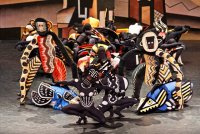 © Mathieu Rousseau
© Mathieu RousseauBoth the philosopher Jean-Luc Nancy and the choreographer Faustin Linyekula have intensively dealt with the question of the “creation of the world”. While Nancy in his eponymous publication raises fundamental questions on the change of values in times of globalisation, Faustin Linyekula is concerned with the concrete repercussions of colonialism on our present-day body images and scopes for movement. When both meet for the first time in person for this discussion, their different perspectives will ask the question as to the possibilities of “translation” between philosophy and choreography. Are art and philosophy themselves subject to the economic laws of the global markets today, or do they create “counter-worlds” – and thus open up potential spaces of critical reflection?
Faustin Linyekula (CGO/F) choreographer
Jean-Luc Nancy (F) philosopherModeration:
Claire Rousier (F) dance scholar
Fri, 7 June 12:00
-
12:15 - 13:00 Capitol, Club Video
Act of Empowerment
A Dialogue on the Bodies of Dance in Arab Cultures
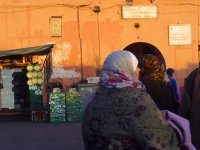 © Sandra Noeth
© Sandra NoethDancing bodies in Arab and especially in Islamic cultures are often read, named, described and represented on the backdrop of ‘patrimonial’, religious, mystical and ancestral heritage and traditions. However, it seems important to see the variety and richness of materials and unique entries that choreographers and dancers keep on developing in the very friction between and enriched by local and universal forms of expression.
More than ever, contemporary dance in the Arab region appears as a living art, which stimulates and incorporates change. Nedjma Hadj-Benchalabi and Sandra Noeth therefore grasp contemporary dance production as equally physical and discursive “act of empowerment” which are nourished and contaminated by a state of emergency with an inherent sense of (public) engagement and involvement. Dance seems to be for the artists and the public almost an attempt to formulate a response and to stay in dialogue with the complex demands and the deep transformations in the order of the world.Nedjma Hadj-Benchalabi (B) curator
Sandra Noeth (D) dance scholar, curator -
12:15 - 13:00 Capitol, Theatersaal Video
Human, Animal, Thing
Border Shifts in Modern and Contemporary Dance
Animals “inhabit” dances and choreographies in various ways. Embodiments in dance evoke different images of movements and transformations. Since the so-called animal dances of the 1920s, an objectification is taking place that is expressed in exotic and colonising practices of representation. In which way does the “animal” become a research figure for the knowledge of movement? And how does a longing for a “different human” reveal itself in the mirror of the animal?
Gabriele Brandstetter (D) dance scholar
Fri, 7 June 13:00
-
13:00 - 13:30 tanzhaus, Studio 1, 2 & 6
TanzSprint 2013
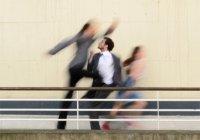 © Miranda Glikson
© Miranda GliksonEach year, students of the Frankfurt Master’s study programme Contemporary Dance Pedagogy (MAztp) organise the one-week workshop festival ‘TanzSprint’ for amateur and professional dancers. For the Dance Congress they have developed various physical-dancerly training offers from current working material on dance techniques and digital tools, which will take place daily, parallel in five studios. In teachings à 30 minutes, a broad range of new training approaches will be tested. Contemporary exchange and mediation formats provide a wide variety of experiences with the art form.
Zoé Alibert, Anja Bornšek, Patricia Gimeno, Miranda Glikson, Jason Jacobs, Gregory Livingston, Ola Scibor (D) students of MAztp
Concept:
Ingo Diehl (D) direction MAztp, Hochschule für Musik und Darstellende Kunst Frankfurt/M.Space Walk tanzhaus, Studio 1
This workshop will examine spatial environment as an extension of our selves.
Referencing spatial atmospheres and architectural principles we will physically experience how spaces organise our body and define movement behaviour. In a focused 30-minute exploration movement tasking and awareness approaches deal with the structures of our surrounds. Engaging with the notion of borders, of inside/outside and public/private realm, we explore the temporal qualities of spatial conditions.Miranda Glikson (AUS/D) dancer
The TK Shuffle tanzhaus, Studio 2
“[...] it’s about walking, moving the arms, turning and jumping.” (DVD 1, A Choreographer’s Score, 2012) The cornerstone from which this physical training will be constructed, references „A Choreographer’s Score“ by Anne Teresa de Keersmaeker. We will explore simple elements, maneuvering the “minimal of material in a maximum way“. Unfolding into accumulation, the space confronts our relationships to others within “simple geometrical underlying patterns“.
Gregory Livingston (USA/D) dancer, choreographer
Moving Oppositions tanzhaus, Studio 6
This physical exploration is a response to Jason’s experience working with choreographer Hofesh Shechter and inspired by the publication “A Choreographer’s Score” by Anne Teresa De Keersmaeker and Bojana Cvejić. Our movement is stimulated by imagery and organised by choreographic structure. Physicality is proposed through a focus on movement quality, which incorporates opposing concepts of soft and sharp, continuous and broken, heavy and light. Individual corporeal engagement connects to a collective movement experience questioning assumptions and possibilities of choreographic structure.
Jason Jacobs (D) choreographer, performer, dance teacher
-
13:30 - 14:00 tanzhaus, Studio 3 & 4
TanzSprint 2013
 © Miranda Glikson
© Miranda GliksonEach year, students of the Frankfurt Master’s study programme Contemporary Dance Pedagogy (MAztp) organise the one-week workshop festival ‘TanzSprint’ for amateur and professional dancers. For the Dance Congress they have developed various physical-dancerly training offers from current working material on dance techniques and digital tools, which will take place daily, parallel in five studios. In teachings à 30 minutes, a broad range of new training approaches will be tested. Contemporary exchange and mediation formats provide a wide variety of experiences with the art form.
Zoé Alibert, Anja Bornšek, Patricia Gimeno, Miranda Glikson, Jason Jacobs, Gregory Livingston, Ola Scibor (D) students of MAztp
Concept:
Ingo Diehl (D) direction MAztp, Hochschule für Musik und Darstellende Kunst Frankfurt/M.3, 2, 1 ... Action tanzhaus, Studio 3
In this physical exploration we utilise Newton’s Law of Action and Reaction as guidance to work with weight, resistance and absorption. Integrating the concept of gravity from “Material for the Spine” by Steve Paxton, we navigate back and forth between the centre of the body and its reactions to the periphery. Using different games and interactions participants play, move and dance!
“If you hit the ground rolling, all the landing energy can be transformed and redirected parallel to the ground, rather than harshly perpendicular to it.” (Material for the Spine. Contredanse. 2008)Patricia Gimeno (ES/D) dancer, performer, dance pedagogue
Collective Practice for the Spine tanzhaus, Studio 4
Drawing from Steve Paxton’s (Material for the Spine) and Alice Chauchat’s scoring proposal (Collective Sensations Practice), we will use our spine as a source of experiential information, allowing it to organise and establish individual moving environments. By verbally offering physically perceived information into the space, we build a score based structure. Growing and branching it collectively, enables us to tackle strategies of relations, decision-making and processes of contextualisation on an individual as well as a group level.
Anja Bornšek (D) somatic movement educator
-
13:30 - 14:45 tanzhaus, Großer Saal
Christoph Winkler
Dance! Copy! Right?
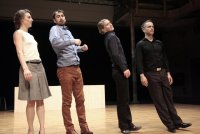 © Heiko Marquardt
© Heiko Marquardt At which point is a movement really mine, and when does this movement become art? The law only protects combinations of steps, but what about the context, or when nobody dances? What would be the smallest element of a combination of steps? Is an individual movement comparable to a note? Can there be something like a “real copy” in dance? How does one and the same movement differ, when it is performed by different dancers? And what does music have that we don’t have?
The piece ‘Dance! Copy! Right?’ is based on a concrete copyright lawsuit at the regional court of Nuremberg/Fürth, to which choreographer Christoph Winkler was summoned as a legal expert. The performance uses the situation of a court hearing and has different dancers present the same sequences of movements. Based on the inevitable differences that arise, the fundamental problems and questions of copyright law and intellectual property will be discussed.In German and English
Concept:
Christoph Winkler
By/with Chris Daftsios, Luke Garwood, Katharina Meves, Nicola Schössler
Costumes Bianca Karaula
Light André Schulz
Production dramaturgy ehrliche arbeit – freies KulturbüroA production by Christoph Winkler in cooperation with ehrliche arbeit – freies Kulturbüro, Heinrich-Böll-Stiftung, Sophiensaele
Funded by Der Regierende Bürgermeister von Berlin – Senatskanzlei – Kulturelle Angelegenheiten
Supported by Phase 7
Fri, 7 June 14:00
-
14:00 - 15:30 Capitol, Club Video
Motion Bank Score Release
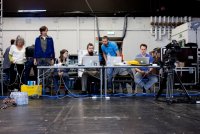 © Jessica Schäfer
© Jessica Schäfer‘Motion Bank’ is a research project of The Forsythe Company focusing on exploring the potential of computer-based tools and techniques to translate choreographic principles. Through modern computer technology, the choreographies of a select group of artists are turned into digital scores that will be published online. This direct access to the compositional principles of choreographic work is to be used by different fields including dance education and digital arts practices. At the Dance Congress, the interactive score created from three different adaptions of Deborah Hay’s solo ‘No Time to Fly’ will be presented for the first time. Deborah Hay, William Forsythe and the digital artists Florian Jenett and Amin Weber give insights into the development process. Jonathan Burrows and Matteo Fargion share reflections on their score project to be released in November 2013.
William Forsythe (D), Deborah Hay (USA), Jonathan Burrows (UK) choreographers
Florian Jenett (D), Amin Weber (D) digital artists
Matteo Fargion (I/UK) performer, composer
Moderation:
Scott deLahunta (D) project leader Motion Bank
Motion Bank is supported by Kulturstiftung des Bundes, Kulturfonds Frankfurt RheinMain, Hessisches Ministerium für Wissenschaft und Kunst, Altana Kulturstiftung -
14:00 - 17:00 tanzhaus, Studio 1
Transition-Consulting by Stiftung TANZ
What comes after one’s career as a dancer? And how can the transition to another profession be carried out? Stiftung Tanz – Transition Zentrum Deutschland, founded in 2010, offers professional dancers from the entire Federal Republic of Germany information, support, guidance, transition workshops, and small grants for further education so that dancers can prepare themselves for a new professional life. At the Dance Congress, a psychologist of the foundation answers questions of dancers who would like to talk about their transition. Consultation is free of charge and anonymous.
Registrations for twenty-minute individual consultations can be made at the Info Counter in the Congress VenueHeike Scharpff (D) psychologist
Stiftung TANZ – Transition Zentrum Deutschland
Fri, 7 June 15:00
-
15:00 - 15:45 Capitol, Studio Video
Aging Body in Dance
The Cultural Politics of Age in Euro-American and Japanese Dance
In Euro-American artistic dance, the aging body has been a taboo subject for a very long time. Despite all aesthetic and ideological revolutions, even postmodern dance was based on the notion of a young, flexible dancer body. In Japanese dance aesthetics, in contrast, “aging” plays an important role. Professional dancers over the age of 80, the best-known example being Kazuo Ohno, are highly appreciated, and a certain traditional repertory is reserved exclusively for children and the aged. The comparison of these different traditions gives rise to the question of whether we can imagine a dance practice without naively aestheticised body images.
Nanako Nakajima (JP/D) dance scholar
-
15:00 - 16:45 tanzhaus, Studio 6
Beyond the Binary
Indigeneity in Choreographic Practices in the South Pacific
For indigenous people in the South Pacific region, dance is the most important means of expressing their identity. Their choreographic practice can no longer be categorised using the Western concepts of “traditional” or “contemporary”. Together with Katerina Teaiwa and Carol Brown, the choreographer Jochen Roller, who is regularly active in the South Pacific region, will examine different choreographic practices. The anthropologist Katerina Teaiwa presents the work of the Banaban Dancing Group from the island republic of Kiribati, which is inextricably linked to their people’s strive for independence. The group deliberately makes use of dance influences from around the world and yet grasps its work as a unique expression of Banaban culture. The choreographer from New Zealand Carol Brown describes how in the works of her choreography students patterns of ritual dances co-exist with Western methods of composition.
Carol Brown (NZ) choreographer, dance scholar
Katerina Teaiwa (AUS) anthropologistConcept/Moderation:
Jochen Roller (D) choreographer -
15:00 - 16:45 tanzhaus, Studio 4
The Value of Dance
How should we define the value of dance in the arts and society? Are there ways to implement distinct structural enhancements? Arts Councils and national dance institutions are asked to mediate between artists, audience and policy makers in order to attract the attention and visibility the dance deserves. Exemplary international dance professionals in the field of promoting dance present their strategies on how they are making the case for dance in their respective countries. Short inputs will be followed by a wider discussion. How can we better negotiate conditions for dance to develop in our countries but also on a transnational level?
With Arts Council England, Centre National de la Danse, Institute of Music and Dance Poland, Dance UK, Reso-Tanznetzwerk Schweiz, Vlaams Theater Instituut, World Dance Alliance, Tanzfonds and others
-
15:00 - 17:45 tanzhaus, Studio 5
dé-position
Research on the Body’s Agency
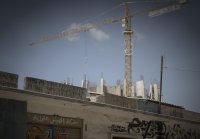 © Lejla Mehanovic
© Lejla MehanovicWe are living in times of far-reaching social and political upheavals, in which the question of the body’s agency is posed anew in regard to situations of protest, revolt and negotiation in the Arab region and elsewhere. In light of these events, the notion of choreography also goes beyond the creation and development of structures and the organisation of movement in time and space: How can chaos and collapse be treated choreographically? Can and should choreography do more than comment on, illustrate or represent processes of radical change? Based on their respective work practices and backgrounds in various disciplines, a group of artists and theorists addressed these questions in more detail during a research meeting in Beirut. Confronted with the challenge of having to perceive and at the same time understand different influences, narratives, contexts, and bodies in face of the current developments, they grasped choreography as a movement of continuous repositioning. Hence, the concept “dé-position” stands for giving up one’s own position, for a physical and discursive change in perspective as the precondition for understanding, evaluating and acting. In two afternoons, Congress participants are invited to share the questions, materials and practices of this research work.
Antonia Baehr (D) choreographer, performer
Claudia Bosse (A) choreographer, director
Tony Chakar (LB) architect, artist
Janez Janša (SLO) choreographer, director, performance theorist
Adrian Lahoud (UK) architect, architecture theorist
Lejla Mehanovic (A) film-, theatre scholar
Sandra Noeth (A) dance scholar, curator
Jalal Toufic (LB) philosopher, artist -
15:45 - 16:45 tanzhaus, Großer Saal Video
Recreating the World of 1923
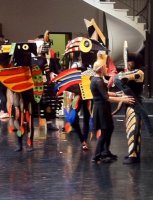 © Kenneth Archer
© Kenneth ArcherIn this lecture demonstration, Kenneth Archer and Millicent Hodson, renowned specialists on the reconstruction of historical dance pieces, give insights into their joint work on the reconstruction of the ballet ‘La Création du monde’, created in 1923 by the writer Blaise Cendrars, the composer Darius Milhaud, the fine artist Fernand Léger, and the choreographer Jean Börlin for the Ballets suédois. This Cubist spectacle featured a mixture of contemporary music, dance and fine art along with fragments of African traditions. After the First World War, “Africa” symbolised the naive possibility of an “entirely different” civilisation. Archer and Hodson show a part of their historical documentation and demonstrate dance movements from the piece.
Millicent Hodson (UK) choreographer
Kenneth Archer (UK) documentarian
Moderation:
Christina Thurner (CH) theatre scholar
Fri, 7 June 16:00
-
16:00 - 16:45 Capitol, Club Video
The Continuity of Discontinuity
Readings about Non-linear Learning
A member of the Judson Church movement, community head in rural Vermont and now mentor of the next generations of dance innovators and coach to renowned dance companies such as Rosas – Deborah Hay’s artistic career is filled with seeming contradictions that, however, form a continuous development when taking a closer look. In her most recent book project, ‘The Continuity of Discontinuity’, the “grand dame” of postmodern dance examines how her understanding of her own creativity has changed through passing on her solo works to professional dancers. At the heart of her works and teachings is the dialogue with the dancing body, which for her always also possesses a spiritual dimension.
Deborah Hay (USA) choreographer
-
16:00 - 18:00 tanzhaus, Foyer
Times in Motion
A Look at Facets of Dance Medicine
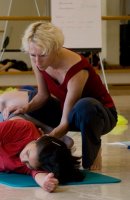 © Susanne Lencinas
© Susanne LencinasIn exercising their profession, dancers are exposed to extreme bodily strains comparable to those of top athletes. Dance medicine allows including the newest scientific insights in the dancer’s everyday professional life. The discussion and consultation offer presents a selection of current topics such as nutrition, fascia, dance and embodiment, aging and the prevention of injuries. At different thematic tables which can be changed every 30 minutes, physicians, scientists, nutritionists, and therapists answer questions and discuss with the Congress visitors.
In German and English
Concept:
Liane Simmel (D) tamed e.V.Nutrition in Dance
For a dancer’s health and efficiency, healthy nutrition and the optimal intake of liquid are just as important as regular training. The most important facts on the issue of ‘Nutrition in Dance’ will be conveyed, the results of a survey on the dietary habits of 243 dancers will be presented and questions answered.Eva-Maria Kraft (A) dance pedagogue, dancer, nutrition trainer
Dancing in a Healthier Way. How Can That Work?
How can one best cope with the physical, mental and aesthetic challenges of the dancer’s profession? Margot Rijven gives advice on a healthier lifestyle, gentle training and the prevention of injuries.Margot Rijven (NL) former coordinator of dance & health de Theaterschool, Amsterdam School of the Arts
Thinking Bodies/Dancing Brains – Dance and Embodiment
What impact did the paradigm change regarding the body-mind problem triggered by the neurosciences have on dance? Which neurophysiological insights are important for dancers and dance teachers?Anja Weber (D) dancer, psychologist, physician
Fascia.
Networks in the Dancing Body
Like cobwebs, a collagenous network of fibres, the so-called fascia, permeate the entire body. How do new insights into the fascia influence dance, what capabilities are attributed to the fascia system and how can they be trained in a targeted way?Liane Simmel (D) dance physician
Danièle-Claude Martin (D) physicist, movement researcher
Fri, 7 June 17:00
-
17:00 - 17:45 Capitol, Club Video
Talks on Dramaturgy
The relationship between choreographers and dramaturges continuously changes during the course of their collaboration. Based on selected productions, William Forsythe, Reggie Wilson and Sidi Larbi Cherkaoui talk with their dramaturges about their role in the artistic process, about research interests and working methods. What kind of knowledge and what competences do dramaturges contribute to the process? How do the translation processes between language and movement evolve? At which moments are dramaturges especially needed and when do they disturb? Is the dramaturgic function actually only reserved to the dramaturge?
For Freya Vass-Rhee, the dramaturge of The Forsythe Company, the company is an ensemble of dramaturges. She understands dramaturgy as a collective process in which the choreographer, the designated dramaturge as well as the dancers and other persons participate. Although several physical and conceptual dramaturgies are at work, dramaturgical accordance is not prioritised. This working method ensures artistic autonomy and additionally results in works whose “meanings” are not fixed and that remain open for changes. This not only questions the role but also the necessity of the dramaturge. Freya Vass-Rhee has invited William Forsythe and the dancer David Kern to share their views of the dramaturgical ensemble practice.
William Forsythe (D) choreographer
Freya Vass-Rhee (D) dramaturge
David Kern (D) dancer -
17:00 - 18:00 tanzhaus, Kleiner Saal
Silke Z.
Unter Uns!
The Generation Project: Jess Meets Angus
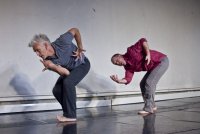 © Meyer Originals
© Meyer OriginalsMen around the age of 50: The American Jess Curtis and the Scotsman Angus Balbernie meet in order to dance, to fantasise, to ramble about their aging bodies, the commencing little ailments, their unused talents, their as yet unfulfilled wishes and dreams. “They can wait, they have a goal without wanting to formulate it. They still have questions, but the answers elude them. Life is too complicated as that one could grasp its meaning in a few words.” (Kölnische Rundschau)
‘Jess Meets Angus’ is episode 2 of the generation project ‘Unter Uns!’, a dance-performance series by Cologne-based choreographer Silke Z. dedicated to different generations and their questions to life.Artistic director/choreography Silke Z.
Dance/performance Jess Curtis, Angus Balbernie
Dramaturgy Alexandra Dederichs
Supervision/Sound André Zimmermann, Felix Marchand
Technical director Ansgar Kluge
Administration Linda Richards
Management/PR mechtild tellmann kulturmanagementA production by Silke Z./resistdance in cooperation with Felix Marchand, Alexandra Dederichs
-
17:00 - 18:30 tanzhaus, Studio 3
Attention Copyright!
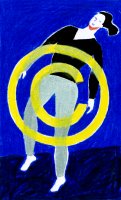 © Tiziana Jill Beck
© Tiziana Jill BeckAccording to German copyright law, works of dance art are also protected. However, this is rarely enforced in practice, since there is no society for reproduction rights for dance in Germany. Of course, permissions must meanwhile be obtained to perform or adapt historical works.
In regard to choreographic recordings on the internet, things are far more complicated, as the case of Beyoncé Knowles versus Anne Teresa De Keersmaeker vividly demonstrated. The workshop gives a brief introduction to German copyright law and deals with questions of the present participants.In German
Rupert Vogel (D) lawyer
Christoph Winkler (D) choreographerConcept/Moderation:
Madeline Ritter (D) qualified lawyer, director TANZFONDS
Supported by TANZFONDS – Eine Initiative der Kulturstiftung des Bundes -
17:00 - 19:00 Capitol, Studio
Working with Deborah Hay’s Motion Bank Score
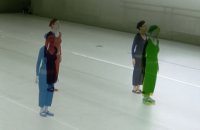 © Amin Weber & Florian Jenett
© Amin Weber & Florian JenettWhen developing an interactive digital score, a live performance is “translated” to a digital medium to explain the relationship between dance in real-time, video recordings and choreographic notes. In this workshop, Congress visitors can experiment with tools and methods created for developing the online digital score of Deborah Hay’s piece ‘No Time to Fly’ for ‘Motion Bank’. Hay’s dancer Jeanine Durning and digital artists Florian Jenett and Amin Weber will provide starting points for drawing inspiration from the digital score to generate new choreographic ideas and forms as well as re-connect with Hay’s specific ways of working.
Registration required
Jeanine Durning (USA) dancer
Florian Jenett (D), Amin Weber (D) digital artists Motion Bank
Supported by Motion Bank -
17:15 - 18:45 tanzhaus, Studio 2
Interweaving Dance Cultures
The interweaving of cultures in and through dance is a tension-filled process of approximation and reciprocal exchange. Here, not only different body concepts and practices as well as various traditions of bodily representation encounter each other. Deviating methods of passing on and updating movement techniques or different models of interaction and collaboration must also be negotiated anew each time. Fellows and members of the International Research Center ‘Interweaving Performance Cultures’ will discuss in detail the forms and limits of such exchange processes together with further Congress guests during so-called tea-times.
Guiding Questions
Which are the central ideas of “Interweaving Performance Cultures” as a new approach? What is special for the Interweaving of Dance Cultures? Which role does the concept of translation play in these processes? How are intra- and intercultural differences acknowledged and dealt with in the Interweaving of Dance and Performance Cultures?Impulses by:
Gabriele Brandstetter (D) dance scholar
Phillip Zarrilli (USA/UK) theatre scholar
Maria Shevtsova (UK) theatre scholarModeration:
Christel Weiler (D) theatre scholarFurther participants:
Navtej Johar (IND) choreographer
Kaite O’Reilly (UK) playwright, dramaturge
Holger Hartung (D) dance scholar
André Lepecki (USA) dance scholar
Susan Manning (USA) dance scholar
Cristina Rosa (BRA/USA) dance scholar
Sabine Sörgel (D/UK) dance scholarConcept:
Gabriele Brandstetter, Holger Hartung (D) dance scholars, Christel Weiler (D) theatre scholar International Research Center ‘Interweaving Performance Cultures’, Freie Universität Berlin
Fri, 7 June 18:00
-
18:00 - 19:30 Capitol, Club Video
New Paths in Funding Dance
In Germany, dance is produced in an enormous diversity, yet it remains barely visible. Productions at permanent houses can often only be viewed locally, rarely do independent projects result in independent companies. What is lacking is flexibility on the one side and continuity on the other. While the artists are already working nationally and internationally, cultural policies still think in delimited spheres: the city, the state, the permanent theatre, the independent scene. Why don’t politicians develop a type of dance promotion that connects cities, states and the federal state with each other? And who should take the initiative?
Reiner Deutschmann (D) cultural-political speaker FDP
Hans-Georg Küppers (D) head of the department of the City of Munich
Bertram Müller (D) Dachverband Tanz
Ute Schäfer (D) minister for culture Land NRW, SPD
Hortensia Völckers (D) artistic director German Federal Cultural Foundation
Short statements:
Gregor Zöllig (D) choreographer, director Tanztheater, Theater Bielefeld
Stefanie Thiersch (D), Helena Waldmann (D) choreographers
Moderation:
Tobi Müller (D) journalist
Concept:
Michael Freundt (D) Dachverband Tanz Deutschland -
18:15 - 19:00 tanzhaus, Kleiner Saal Video
Dance in a Critical Discourse on Aging
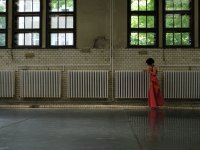 © Rita Roberto
© Rita RobertoSusanne Martin’s lecture demonstration deals choreographically with the ageing female dancer body. She resists the glorification of youth and flawlessness in our society, in the eyes of which the body of a female dancer is always inadequate, always already too old. In her dance and performance practice, Martin seeks means to utilise the critical and subversive potential of the process of ageing. A very personal approach that simultaneously makes reference to discourses that have evolved since the 1990s in the field of “Critical Age Studies”.
Susanne Martin (D) choreographer
Respondent:
Katherine Mezur (USA) dance scholar
Continuous
-
Congress Venue, Foyer
Memories of Dance – Graphic Recording
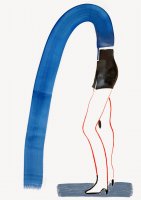 © Tiziana Jill Beck
© Tiziana Jill BeckWhat do you remember about your first, nicest, most touching, or even most terrible dance experience? Images, sounds, movements, moods, people – the illustrator Tiziana Jill Beck and her team are underway with pad and pencil to collect the memories that the Dance Congress participants give an account of, to then render them in sketches and drawings. The constantly growing collection of pictures will be presented in the Congress spaces and published on the Tanzfonds website. In this way, a common memory space of individual dance experiences and encounters will evolve – a dance history in pictures that most certainly cannot be canonised.
Tiziana Jill Beck (D/USA) illustrator
and her team: Johanna Benz, Edith Carron, Anna Hainrich, Marius Wenker
A project by TANZFONDS – Eine Initiative der Kulturstiftung des Bundes -
Capitol, Foyer
Cultural Education by German Dance Ensembles at German Theatres
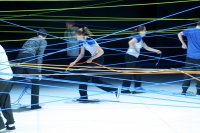 © Thomas Jauck
© Thomas JauckFor many dance ensembles in Germany, cultural education has become an important part of their daily work. It has an effect on all social groups and wins over new audiences for dance at German theatres. Whether spectators are made familiar with dance through public ballet training, rehearsal visits and talks with choreographers, or children and older people gain experiences with their own body in dance projects – these offers always result in long-term relationships and affiliations. A video documentation presents excerpts of various projects and initiatives of municipal ensembles.
Project:
BBTK/Bundesdeutschen Ballett- und Tanztheaterdirektoren Konferenz -
Capitol, Foyer
Books on the Move
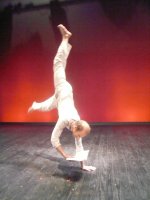 © Claude Sorin
© Claude SorinGuest of the Dance Congress: the mobile bookstore for everyone who dances, reflects and moves. The assortment of this international bookstore for contemporary dance and performance includes books on choreography, applied anatomy and body experience, as well as theoretical essays and biographies in German, English and French. New publications are on offer as well as hard-to-find books on contemporary dance.
Agnès Benoit-Nader (D) booksonthemove.eu
-
Capitol, Foyer
Dance and Aging
Poster Exhibition: Dance in the Second Half of Life
The Gesellschaft für Tanzforschung (society of dance research) presents a poster exhibition of international scientific and/or artistic projects dealing with the topic ‘Dance and Aging’.
Concept:
Gesellschaft für Tanzforschung (GTF)Ästhetisches Interesse an künstlerischem Tanz im Alter – Eine explorative Analyse biographischer Erfahrungen und tätigkeitsspezifischer Vollzugsanreize
Claudia Behrens (D) Johannes Gutenberg-Universität Mainz
Krystyna Obermaier (D) Elementarer Tanz e.V. Köln‚Zwei Flüsse‘ Ein Tanztheaterprojekt für alle ab 55 Jahren – Ein Kooperationsprojekt des Ringlokschuppen (Mülheim) und der Bergischen Volkshochschule Wuppertal
Barbara Cleff (D) Seniorentanztheater Dortmund/Ballett Dortmund
Nicole Schillinger (D) TheaterTanzPerformance ttpProject: ArtRose/Small Moments of Greatness. A collective for dancers “im erfolgreichen Alter”
Jenny Coogan (D) Palucca Hochschule für Tanz DresdenMobileDance Age: an initiative to bring dancers from different generations together in creative processes
Fiona Edwards, Jo Parkes (D) EdwardsParkesDance (EPD)An initiative to bring dancers from different generations together in creative processes
Fiona Edwards, Jo Parkes (D) EdwardsParkesDance (EPD)‚Ahnen‘ – ein Performanceprojekt mit 13 Tänzerinnen im Alter von 62 bis 84 Jahren
Gabriele Gierz (D) My Way Ensemble‘Identities’ – a production involving 5 women, dancers and choreographers over the age of 50: What is the “identity” of the older dancer?
Susanne Kempster (ES)‘Dance and Age – Expression of the Human Body at different Ages’ (Teilprojekt des Forschungsprojektes ‚One of a Kind‘, geleitet von Jiri Kylian an der Rotterdam Dance Academy, Codarts Rotterdam)
Friederike Lampert, Desiree Staverman (NL) Rotterdam Dance Academy, Codarts RotterdamTango im Altersheim: ein tanzpädagogisches Projekt
Florica Marian, Katrin Grüntzig (CH)Dying Swans and dragged up dames: a photographic exploration of the ageing dancer
Helen Newall, Mark Edward (UK) Edge Hill UniversityFreiräume schaffen: Zeitgenössischer Tanz im fortgeschrittenen Alter
Cornelia Widmer, Walter Widmer (D) ForumTanzGesellschaftstanz mit Älteren – ein Mittel zur gesundheitlichen Prävention
Eileen Wanke (D) Abteilung Tanzmedizin, Institut für Arbeitsmedizin, Charité-Universitätsmedizin Berlin/Institut für Arbeits-, Sozial- und Umweltmedizin, Goethe Universität Frankfurt et al. -
Capitol, Foyer
Motion Bank Work Station
The Motion Bank online tools can be tested here.
-
tanz blog
The journal “tanz” is accompanying the entire Dance Congress with a BLOG on tanz-zeitschrift.de. At the BLOGGING station, participants and guests of the Congress can read the BLOG entries and comment on them directly.
Editorial team:
Heike Diehm, Elena Iris Fichtner, Irmela Kästner, Melanie Suchy, Bettina Trouwborst, Arnd Wesemann.